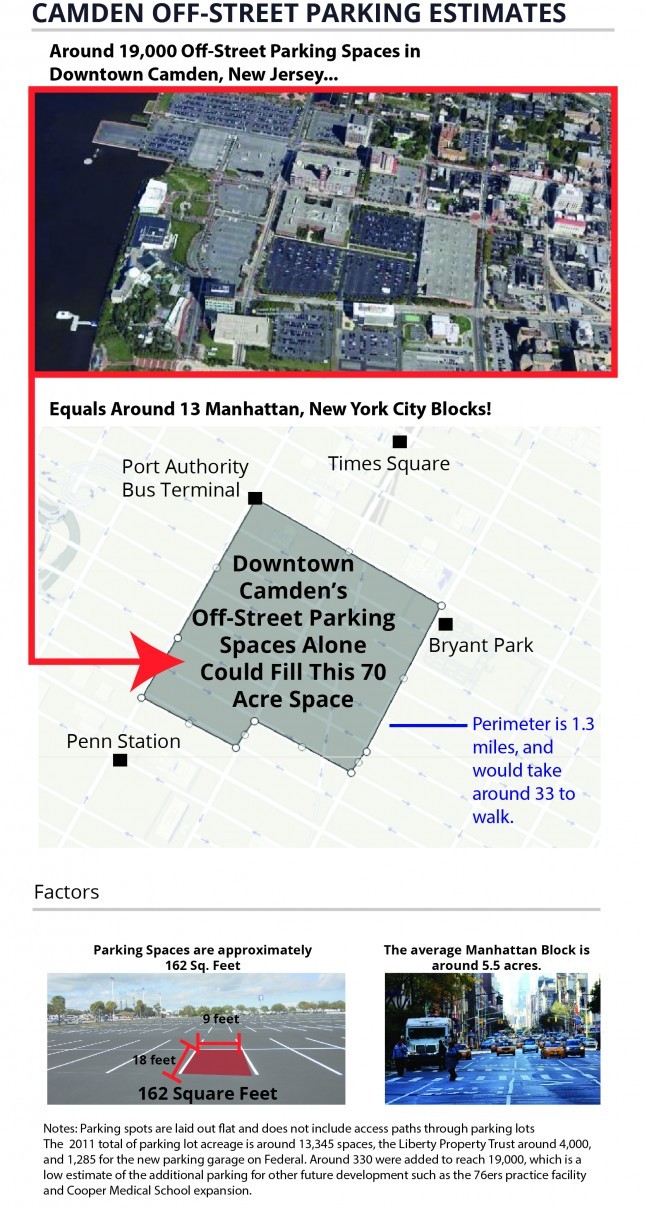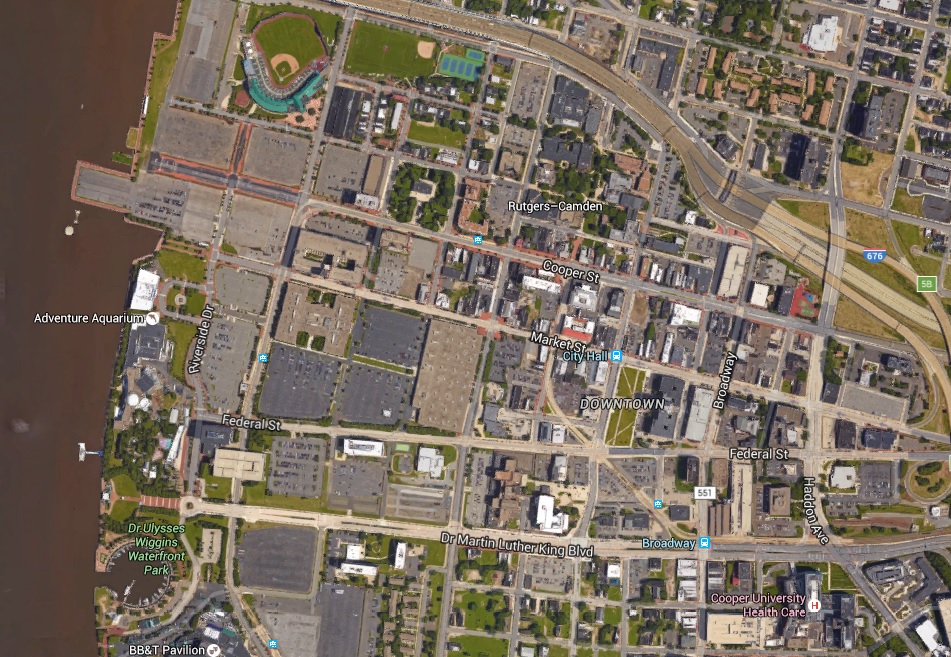Camden, it seems, has learned little from “winning” Streetsblog’s Golden Crater Award last year. The sea of surface parking along the downtown waterfront has long been a public eyesore, but that won’t stop the City from adding even more.
Camden’s Delaware Waterfront development is expected to bring waves of visitors and workers to the area between the Philadelphia 76ers’ 125,000-square-foot practice facility and the Liberty Property Trust’s 26-acre mixed-use project. The City’s knee-jerk reaction to such massive redevelopment is to ensure even more space for parked vehicles.
A few surface parking spots may be lost in the process, but those spaces would be more than made up for with the new parking facilities included in the waterfront’s redevelopment plan. The Camden Parking Authority has plans for a $28 million parking garage housing 1,285 spaces. On top of that, the Liberty Property Trust waterfront project will accommodate another garage with 4,000-plus parking spots.
But downtown Camden already has ample parking. According to a 2011 report by the Delaware Valley Regional Planning Commission, downtown Camden has 13,345 off-street spaces–8,922 of those spots are provided by 62 surface lots, with the remaining 4,423 housed within five parking garages. A separate estimate from 2015 claimed the waterfront had at least 8,500 parking spaces.
The 19,000 parking spaces in downtown Camden would fill roughly 70 acres–the equivalent of nearly 13 New York City blocks.

Despite the abundant planned parking, the existing Central Waterfront area is not entirely auto-centric. The majority of the neighborhood is less than a mile from two PATCO stations and is directly served by two RiverLINE stations. The Waterfront is also accessible via NJ Transit bus service and ferries from Philadelphia. Liberties Property Trust has included plans to run shuttles to the Walter Rand and City Hall transit hubs and to build bike paths in its waterfront redevelopment project.
Camden cannot keep using the projected influx of people to the city as an excuse to justify building even more parking. The city need only look west to Philadelphia or north to Newark for examples of cities and companies accommodating new residents, workers and visitors by using their existing transit networks, rather than creating more space for storing cars.
TSTC Staff Analyst Ryan Hall contributed to this post.


[…] Camden Will Add Some Parking Tumors to Its Infamous Downtown Parking Crater (MTR) […]
[…] used a Safe Routes to School Grant to remove a bike lane and widen an already dangerous road. And Mobilizing the Region relays the disappointing news that the city of Camden is planning to make its awful waterfront […]
I fully believe they don’t want to offend suburbanites’ delicate sensibilities with taking public transportation.
This is just your opinion. There people who live the idea and people who hate it.
Philadelphia has seen a dramatic DECREASE in parking spaces, while not seeing occupancy rates for the remaining spaces increase. Philly is booming, with its sidewalks and bike lanes funneling dollars into its businesses. Camden is being crazy not to try to replicate Philly’s success.
http://planphilly.com/articles/2015/12/31/study-center-city-lost-7-percent-of-its-public-parking-spaces-in-the-last-five-years
This is a good thing. The movement toward parking structures and away from surface parking is just one step to returning Camden to its dense urban core. The development in later stages will be able to utilize the land area freed up by the utilization of the 76ers and Liberty Property’s garages as well as existing under-utilized lands (i.e. surface parking lots) with developers advocating for reduced parking requirements and improved transit connections. There are many more steps that need to be taken by Camden’s decision makers to allow the pendulum to swing back away from auto-centric developments. The City must be steadfast in its solicitation of good developers and the regulations in place to ensure the type of development necessary for to rebuild the City. Prostituting itself to the first “John” for a quick dollar will not bring about the desired change but rather move the city closer to the obsolete and unsustainable suburban office park development type already apparent in Camden’s Waterfront.